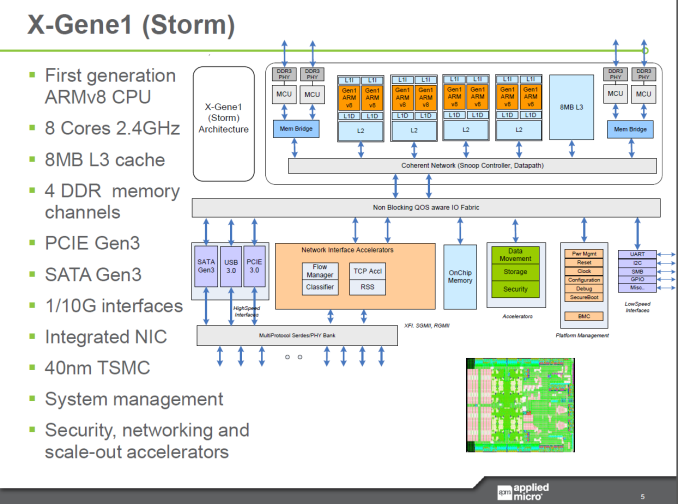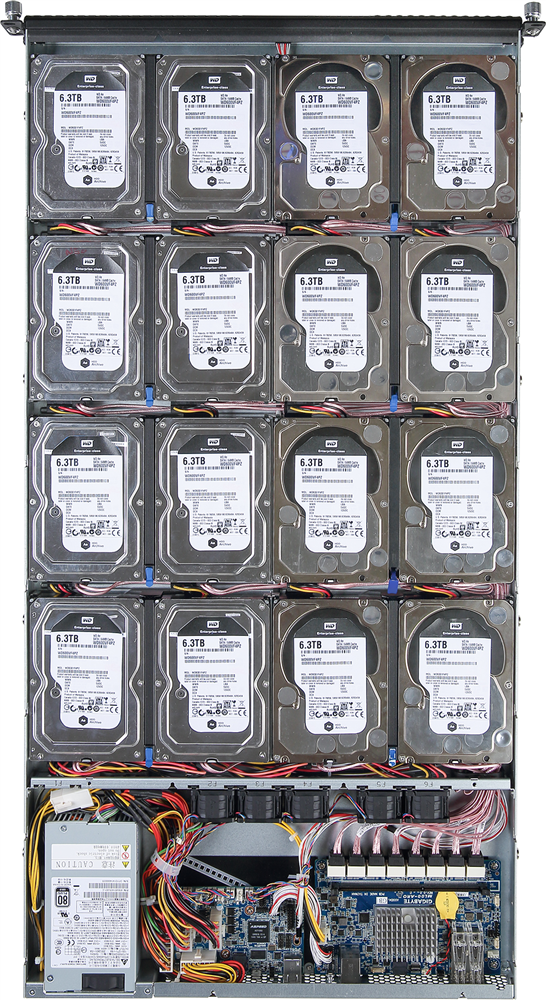GIGABYTE Server Releases ARM Solutions using AppliedMicro and Annapurna Labs SoCs
by Ian Cutress on March 24, 2015 12:51 PM EST
As Johan points out in his deep dive of ARM in the server market, given a focused strategy new ARM solutions can offer the potential to disrupt some very typical x86 applications. Migrating from the ARM instruction sets or the ARM architecture into something in silicon is one part of the equation, then producing something more tangible has been the quest of a few solution providers. Typically these solutions all focus on enterprise as one would expect, and it would take time to filter down depending on use case and application. It would seem that today, for the opening of the WHD.global event in Germany, GIGABYTE’s server arm is launching a couple of ‘Server on a Chip’ solutions.
First up is a model built around the AppliedMicro X-Gene under the ARMv8-A architecture. The MP30-AR0 uses the 45W X-Gene1, a 40nm eight-core solution running at 2.4 GHz using pairs of cores shared L2 cache with an overriding 8MB L3 cache.
The system uses quad channel DDR3 with ECC, exploiting two DIMMs per channel for a total of 128GB. Two 10GbE SFP+ ports are supplied, along with two RJ-45 1 GbE ports from a Marvell 88E1512 controller. Four SATA 6 Gbps ports are part of the SoC, along with two PCIe 3.0 x8 slots in an x16 form factor. No USB 3.0, but USB 2.0 and a VGA output for the AST2400 server control IC included, which means another control network port on the rear-IO.
The MP30-AR0 is compliant with ARM Server Base System Architecture (SBSA) and Server Base Root Requirements (SBBR) standards, and is designed for cloud and scale-out computing. While GIGABYTE’s server division has been hard at work enabling their products to be sold at retail, the ARM based platforms will most likely be a distributor b2b only offering, at least of now. This motherboard/SoC system will also be available in a 1U server rackmount (the R120-P30) with four hotswappable bays and a single PCIe riser card, as shown above.
On the storage side, GIGABYTE Server is releasing the D120-S3G, a rackmount powered by the Annapurna Labs Alpine AL5140, which translates as a 1.7 GHz Quad A15 solution running at a 10W TDP relying on ARMv7 for the instruction set.
This system seems more for cold-storage, offering support for 16 SATA 6Gbps drives with RAID 5 and RAID 6 both supported. The motherboard has only one memory slot, but two gigabit Ethernet ports are flanked with two 10GbE integrated SFP+ ports as well. An AST2400 supplies the network control, and GIGABYTE is stating support for LTS Linux Kernel 3.10 and Ubuntu 14.04. If the product page is anything to go by, this is still technically a work in progress as they have not officially announced any other connectivity.
No word on release dates or pricing, although demonstrations at events can mean they might go on sale within the next couple of months.



















16 Comments
View All Comments
Samus - Tuesday, March 24, 2015 - link
The Ae drives are certified for 16-bay storage arrays (vibration) although mechanically they look like the Re/Black (which have the spindle locked at both axis') so the difference likely comes down to firmware and perhaps an additional sensor.patrickjp93 - Wednesday, March 25, 2015 - link
Funny, because Google only uses consumer-grade drives in its data centers. --Dr. Keith Fricken, Google DBAandychow - Tuesday, March 31, 2015 - link
Yes, but Google uses their own distributed file system. It's not raid 6. It's like ZFS-3, self-healing, on steroids. They could lose a whole lot of disks and not lose any data. They can do this because they are massive. Most businesses don't have tons of clusters with thousands of disks on hundreds of servers. They don't say how many servers they have for data, but estimates place the number in the hundreds of thousands.Also, it's not that fast: "when used with relatively small number of servers (15), the file system achieves reading performance comparable to that of a single disk (80–100 MB/s), but has a reduced write performance (30 MB/s), and is relatively slow (5 MB/s) in appending data to existing files."
ruthan - Wednesday, March 25, 2015 - link
Hmm, i wanna see some benchmarks and some real ARM Linux, because i far as know, there is some arm Ubuntu, Fedora, Debian, but feature list is pretty much limited in comparison to x86 version.KellyC82 - Saturday, March 28, 2015 - link
>but feature list is pretty much limited in comparison to x86 version.Not really. My Debian Stable armhf system right now shows about 300 installed packages and about 41,800 available. My Debian testing AMD64 + i386 as a foreign arch has some 68,000 total packages (not double what one arch would have, since some are arch independent).
armhf has 157 packages in database. 1148 in java. 397 in mail. 1666 in net and 1123 in web.
Pretty much the entire Gnome and KDE desktops are there, if you want to talk desktops.
nonotme - Wednesday, March 25, 2015 - link
I'd really like an armv8 server but:Slower than Avington
Hotter than Avington
Is it cheaper than Avington?